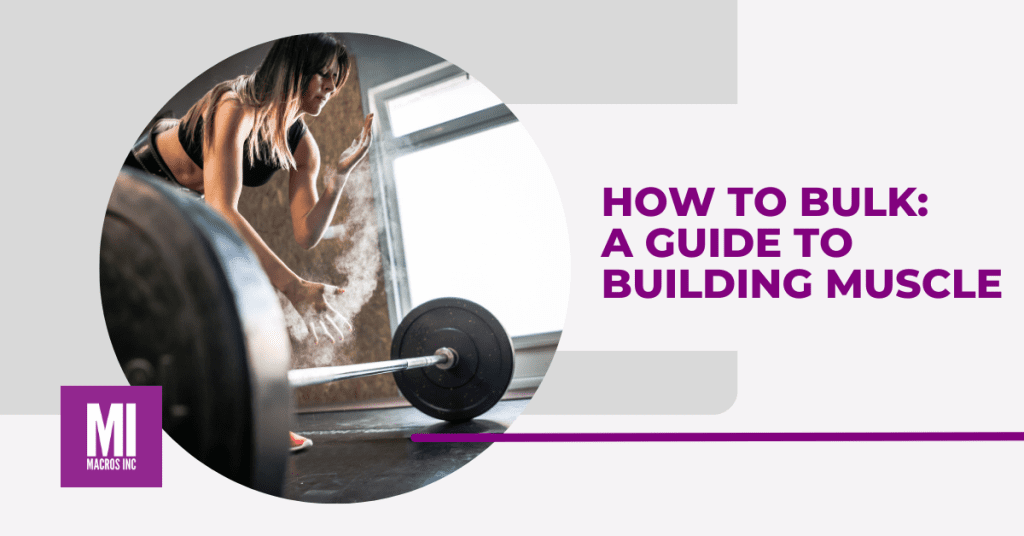Everybody wants to lose weight, but you can only lose weight for so long. Once you have reached the bottom end of healthy body fat levels, there is simply no more tissue to lose before some health consequences set in.
Getting to the low teens of body fat percentage for women, or the low single digits for men will result in compromised bodily functions, a plummeting sex drive, and hormonal health risks.
The endless articles on weight loss will not help you at that point. So as useful as weight loss is, weight gain can be highly desirable, but it is not talked about as much.
In fact, controlled weight gain can be healthy and beneficial if you are too lean, want to maintain a higher calorie lifestyle, boost strength performance, or simply want to pack on some size. Who does not like bigger biceps or glutes right? Read on to find out how to bulk in our all-encompassing guide!
Jump to a Topic
What is Bulking?
At its core, bulking refers to a period of intentional calorie surplus, where you consume more calories than your body needs for maintenance. This surplus provides the extra energy required to support muscle growth and repair processes. By supplying your body with a surplus of nutrients, particularly protein, you create an environment conducive to muscle hypertrophy.
Most people, especially women cringe at the term bulking. It reminds them of excessively veiny bodybuilders who struggle to fit through a sedan’s door. But despite the bad rep, bulking is merely a controlled weight gaining phase. A successful bulk will slap on as much muscle and as little fat as possible.
So maybe we need a better word than bulking… maybe strategic jackedness, or something super cool like that.
Benefits of Bulking
Bulking offers several advantages for individuals aiming to build muscle and improve their overall physique:
a) Increased muscle mass: The primary goal of bulking is to stimulate muscle growth. By providing your body with the necessary nutrients and surplus calories, you create an environment that promotes the synthesis of new muscle tissue.
b) Improved strength: As you gain muscle mass during your bulk, you can expect to see significant improvements in your strength levels. This increase in strength not only enhances your performance in the gym but also translates into functional benefits you’ll notice in your day-to-day life.
c) Enhanced metabolism: Bulking can have a positive impact on your metabolic rate. With an increase in muscle mass, your body’s energy expenditure at rest (known as basal metabolic rate) increases. This means that even outside of your workouts, you burn more calories, making it easier to manage your body composition in the long run.
Debunking Bulking Myths
Unfortunately, several misconceptions surround bulking that can deter individuals from embarking on this muscle-building journey. Let’s address some of these myths:
Myth 1: Bulking inevitably leads to excessive fat gain.
While bulking does involve a calorie surplus, the goal is to gain muscle mass rather than just accumulating fat. By implementing a well-structured bulking plan, paying attention to proper nutrition, and monitoring progress, you can minimize fat gain and maximize lean muscle growth.
Myth 2: Bulking results in loss of muscle definition.
Though bulking may temporarily obscure muscle definition due to increased body fat levels, it is a necessary phase for muscle growth. Following a bulking phase, a well-planned cutting phase can be implemented to shed excess fat and impressive results of your bulking phase to the world.
Myth 3: Bulking is only for men.
Bulking is not exclusive to men. Women also greatly benefit from bulking, as it allows them to build muscle, enhance strength, and achieve their fitness goals. However, the approach and calorie surplus may vary based on individual needs and preferences.
How to Bulk Successfully for Muscle Gain
Strength Training
Cardio is great, but it does not stimulate as much muscle growth as strength training. This is important because you want to stimulate as much muscle growth as possible. The more muscle growth you can demand from your body, the more likely the extra calories will go towards lean tissue.
Eating in caloric surplus without lifting weights defeats the purpose of bulking. You are now storing more fat with little muscle to show for, thus a good strength training program is critical. This doesn’t mean you cannot do cardio or other forms of exercise, but strength training should now be the priority if it was not already.
If you are already strength training, bulking is also a time to increase your training volume as well. You will be eating more food and have more energy to recover from more sets.
MORE FOOD + MORE LIFTING = MORE MUSCLES
Strength Training Programs
Here are two comprehensive workout guides that can help you to maximize the results from your bulk:
6-Day PPL Workout Guide:
Our 6-Day PPL (Push, Pull, Legs) workout plan is designed for intermediate to advanced fitness enthusiasts. It spans 12 weeks and focuses on specific muscle groups on designated training days, ensuring maximum efficiency and recovery.
Key Details:
- Equipment Required: Barbell, Dumbbells, Machines
- Program Duration: 12 weeks
- Time per Workout: 45-60 minutes
- PPL Breakdown: The 6-Day PPL program is organized into Push, Pull, and Leg days.
- Push Day: Focuses on chest, shoulders, and triceps.
- Pull Day: Targets back, traps, and biceps.
- Leg Day: Strengthens quads, hamstrings, and calves.
4-Day PHUL Workout Guide:
Our 4-Day PHUL (Power Hypertrophy Upper Lower) program spans 12 weeks, providing ample time for your body to adapt and grow. It balances power and hypertrophy for a well-rounded workout experience.
Key Features:
- Equipment Needed: Barbell, Dumbbells, Machines
- Days Per Week: 4
- Workout Duration: Each session takes 45-60 minutes.
- Workout Split: The PHUL plan is divided into four workout days, each focusing on power or hypertrophy.
Power Day – Upper Body (Day 1):
- Focuses on building upper body strength.
- Includes exercises like Bench Press, Barbell Row, Incline Press, Lat Pull Down, Overhead Press, Bicep Curl, and Skullcrushers.
Power Day – Lower Body (Day 2):
- Targets lower body power and development.
- Comprises exercises such as Squat, Deadlift, Leg Press, Leg Curl, and Standing Calf Raise.
Hypertrophy Day – Upper Body (Day 3):
- Concentrates on upper body muscle growth.
- Incorporates Incline Bench Press, Seated Cable Row, Dumbbell Chest Fly, Dumbbell Row, and Dumbbell Lateral Raise.
Hypertrophy Day – Lower Body (Day 4):
- Aims to enhance lower body size and definition.
- Includes Squat, Bulgarian Split Squat, Leg Press, Leg Curl, and Leg Extension.
Download our 6-Day PPL Workout Plan, here.
Download our 4-Day PHUL Workout Plan, here.
Training Is Only One Piece of the Puzzle
It’s crucial to understand that your training regimen is just one aspect of a successful bulking strategy. While an effective workout program, such as our 6-Day PPL or 4-Day PHUL guides, plays a significant role, it should complement a well-rounded approach to bulking.
Let’s explore the other moving parts of a bulk that you need to get right to ensure you build muscle efficiently.
Start with a Small Calorie Surplus
The higher the potential for muscle growth, the bigger your surplus can be. So a beginner lifter can eat a bigger surplus than an advanced lifter.
Nonetheless, it is best to err on the side of a smaller surplus. You can always go bigger if need be, but eating too much too fast merely results in needless fat gain (been there, done that, no bueno).
A calorie surplus of about 200-500 above your maintenance is a good starting point. The goal is to fuel the muscle growth that you’re stimulating without it spilling over to too much fat gain.
Do not fall into the bad advice of a dirty bulk where you gorge yourself in food because you cannot force-feed more muscle. A good solid bulk will allow for more food, but it is not an excuse to empty out a buffet every weekend.
Tailor your Macros for Muscle Gain
To calculate your macros for muscle gain in the easiest way, consider using a macro calculator before beginning your bulk. Macro calculators provide precise and personalized calculations based on factors such as age, gender, weight, height, activity level, and goals. By accurately estimating your energy output and protein requirements it gives you the best starting point to build results from.

Monitor your Progress
As we discussed, beginners can get away with a bigger surplus, so they will be able to gain muscle faster.
A good rule of thumb is that a beginner can aim for 0.5-1% weight gain each week while an advanced lifter should aim for 0.25-0.5% weight gain each week.
You will need to look at your average each week and see if you’re gaining weight within these ranges. If you are not gaining at all, you need to increase daily food intake by 100-200 calories and retest. While we want to gain weight conservatively to minimize fat gain, we do not want to be too conservative where we are not even gaining weight at all. That defeats the purpose of a bulk.
Take Measurements
If you are gaining weight within the appropriate range, that is great. The next step is to take waist measurements each week. If your waist measurements stay the same each week while weight goes up, it means you are gaining muscle with very minimal fat gain. That is great and for those who are more risk tolerant, you can even increase your surplus to build muscle faster, so long as the waist measurements don’t balloon up.
If your waist measurements are increasing quickly especially early in your bulk, it means your surplus is too big and too many calories are spilling over to needless fat gain. You need to reduce your surplus by about 100-200 calories and aim for slower weight gain.
Work with a Nutrition and Fitness Coach
It’s possible to see great results working by yourself but working with a nutrition and fitness coach can take your results to the next level. Having a coach on hand to dial in your nutrition, form your training plan and monitor your progress frees up your time and energy to focus on lifting weights and building muscle.
The accountability and guidance a 1-to-1 coaching program offers is unrivalled when it comes to making gains. If you want to find out more about working with a coach, follow the link below to download our coaching guide or head over to our coaching page to learn more, sign up or speak to one of our team!

Be Patient
Rinse and repeat this process for a few months depending on how much weight you would like to gain. Keep in mind, constructing new muscle tissue takes time. It is much easier to lose a pound of fat than it is to gain a pound of muscle, so be patient and stick with it.
Just like you do not want to yoyo diet, you do not want to yoyo bulk either because you will stay at the same weight with no muscle growth to show for. A bulking phase should last at least 2 months to ensure noticeable muscle growth.
So to sum up the key points of a successful weight gain. Lift weights, eat a little bit above your maintenance, measure progress, adjust and be patient because nobody gets jacked overnight.
Try our nutrition coaching, for free!
Be the next success story. Over 30,000 have trusted Macros Inc to transform their health.
Simply fill out the form below to start your 14-day risk-free journey. Let's achieve your goals together!


